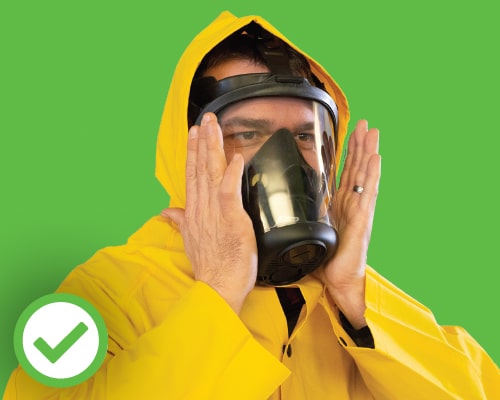Ensuring personal safety equipment is ready for the start of the busy season.
One of the items at the top of Bradley Gregg’s spring safety checklist is ensuring that his team’s personal safety equipment is in good working condition and every employee who handles anhydrous ammonia (NH3) has a functional respirator ready to go.
Well before the start of the busy season, Gregg, manager of Terraco’s Stonewall, Man. branch, makes sure employees are trained on how to adjust and use their respirator, as improper fit, usage or maintenance can negate its effectiveness.
Facial hair can compromise the respirator’s seal, so Gregg advises his employees to stay clean-shaven for the duration of NH3 season or whenever they could require a respirator. For hygiene, Gregg says the respirators are assigned for personal use and not shared.

Do: Be Clean-Shaven and Wear all Required PPE
Facial hair that lies along or crosses the respirator’s sealing area, such as beards, stubble, sideburns and some mustaches, will interfere with respirators that rely on a tight facepiece seal to achieve maximum protection.
According to the U.S. Centre for Disease Control and Prevention, the presence of facial hair under the sealing surface causes 20 to 1,000 times more leakage, compared to clean-shaven individuals, and just a day or two of stubble growth can reduce protection.
Do: Conduct a User Seal Check
A user seal check must be conducted every time the respirator is to be worn, to ensure an adequate seal has been achieved. Once the user has properly adjusted the mask for a snug fit, he or she removes the canisters and uses their hands to block the openings.
Then, the user either exhales gently to do a positive pressure seal check, or inhales sharply for a negative pressure seal check. By doing so, the user will be able to tell if the seal is adequate by the positive or negative air pressure created in the mask – if air escapes or enters the mask, the seal is not adequate.
You want to make sure you’re well ahead of the game, so by the end of March you’re
basically ready
for anything.
Do: Get an Early Start
Although every retail has their own version of a spring checklist, Gregg’s advice to fellow retailers is to get a jump on their equipment maintenance and staff training, because the start of the season can be unpredictable.
“Don’t leave it to the last minute,” he says. “Begin early to make sure you're well prepared, because you never know if spring is going to start April 10 or if it’s going to start May 10. You want to make sure you're well ahead of the game, so by the end of March you're basically ready for anything.”
Related Articles
- Ag Retailer Tips for Safety Robert Gobeil, Ag Health and Safety Specialist for the Canadian Agricultural Safety Association (CASA) recently provided insights about safety from an ag retailers’ perspective Gobeil talked about the impact incid...
- E2 Regulations Update New regulations increase the frequency of live emergency simulations. Environment and Climate Change Canada’s revised Environmental Emergency (E2) regulations are encouraging a higher level of emergency preparedne...
- Keeping in Contact with Remote Employees Investing in satellite communication is good for employee safety and productivity. It’s no secret that cellular service in parts of rural Canada can leave something to be desired. The issue was headline news this...
- Stop. Think. Act. Building a behaviour-based culture of safety. Building a behaviour-based culture of safety. When D’Arcy Smith made the transition from automotive manufacturing to agriculture, he noticed that the industry was som...
- Breaking Barriers to Safety Industry experts offer solutions for implementing safe workplace practices on the farm. Industry experts offer solutions for implementing safe workplace practices on the farm. Producers know they should take the ...
 How to resolve AdBlock issue?
How to resolve AdBlock issue? 


Join the discussion...
You must be logged in as a CAAR member to comment.
Report
My comments